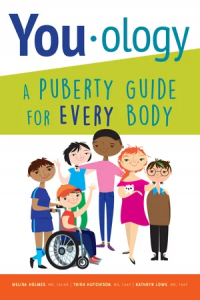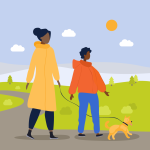A New Puberty Guide for Kids Aims to Replace Anxiety With Self-Confidence
 The authors of a new book on puberty had trouble coming up with a name. The guide to growing up, for pre-teens 9 to 13, is written for all kids – girls, boys, nonbinary youth. It’s inclusive of the gender spectrum and the trans experience.
The authors of a new book on puberty had trouble coming up with a name. The guide to growing up, for pre-teens 9 to 13, is written for all kids – girls, boys, nonbinary youth. It’s inclusive of the gender spectrum and the trans experience.
They settled on You-ology: A Puberty Guide for Everybody. The slim, 150-page guide, published by the American Academy of Pediatrics, is one a handful of recent puberty books that aim to be more inclusive. It explains body parts and how they change in clear, accessible ways, while assuring kids that there’s a wide range to what is normal. Big feelings, big questions and growing faster or slower than other kids are all part of it.
The text is strewn with colorful diagrams, fun facts and stories from a diverse cast of fictional characters navigating puberty.
Two of the authors, Dr. Trish Hutchison, a pediatrician and Dr. Melisa Holmes, an OB/GYN, teach puberty classes and co-founded an online puberty education hub called Girlology. The third, Lowe is a pediatrician who helps steer the AAP on lesbian, gay, bisexual, transgender health and wellness. The idea for the book grew out of interacting with kids and seeing the need for accurate information that avoids shame.
One early reader endorsed the book. Stella, 12, a sixth-grader from Chicago, who identifies as nonbinary and uses them/them pronouns, read an early copy (their mom is an acquisitions editor at AAP).
“I’m excited about growing up and also kind of nervous about the changes,” they said, “The book was, like, very reassuring because it told me that everything is normal and your body is doing what it needs to be doing.”
Stella thought the book was a good complement to what’s taught at school. They identified with some of the book’s characters (like Oliver, who had glasses like Stella’s and a shared interest in cosplay). Stella also found a diagram about gender identity and expression especially useful, along with a section on “puberty gear” that explains things like bras, binders, athletic cups, period underwear.
A few years ago, when it was in the planning stage, “we wanted this book to be in every school in the country, so that any kid could pick it up and see themselves and their peers,” says Hutchison. That’s unrealistic today, amid a growing tide of anti-trans and anti-LGBTQ legislation, including restrictions on what books can be used in schools. Now, “there are certain states out there where you can’t even say [some] of these words,” Hutchison says.
“Regardless of what’s going on in state capitals, our jobs are to be pediatricians, and to teach kids about their bodies and how to take care of themselves,” Lowe says.
NPR spoke with Lowe and Hutchison about the book, the language of inclusivity, and how using real names for body parts helps combat shame. See the full article on NPR for more details. Excerpted from “A New Puberty Guide for Kids Aims to Replace Anxiety With Self-Confidence.” The book may be purchased from the American Academy of Pediatrics, Amazon and other national booksellers.










